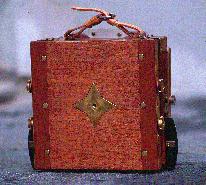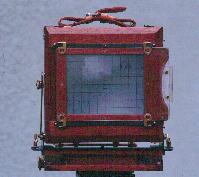LARGE FORMAT CAMERA
| In order to see a larger version of the pictures and get more information,
please click on the images.
When I began the project, I had never used a large format camera. Actually, I had not even seen one in real life! The first thing to do was to buy some items that were not practical
to do myself. I ordered a focusing screen, two sheet film holders, a lens
and a lensboard (Linhof Technica style) by mail-order from Adorama. As you may recognize from the pictures, my camera is a mix
of my two sources of inspiration. It has now served me for more than six years
and five hundred pictures. As far as I have experienced there has been few
occasions when there has been a feeling that the ability of the camera has
limited me in my photography. The camera is built from mahogany, brass and aluminium. Especially
in the back there is much more aluminium than what appears at a first glimpse.
The gears were bought as standard parts. The knobs are actually gears that
have been threaded (or in other ways adapted) and rounded off in order to
give a comfortable grip. If I were to start this project all over again today I would probably have skipped most of the brass and used aluminium more extensively. That would have resulted in a much lighter camera with the same strength. In building this camera, I have had good use of a planer (Thanks
Bo) for giving the right dimensions to the wood and a milling machine (Thanks
Stefan and Altoptronic) for doing slots in the brass bars. I made amny small
metal pieces using a watchmakers lathe (Thanks to my Dad). Finally I bought
a router for making profiles in the wooden pieces. I once started to write a small book on how to design and build
a large format field camera. The intention was to describe principles and
important aspects of the design while the detailed design would be up to
the reader to perform. As time has passed by I start to realize that this
book will never reach the intended audience. I have not had the time to do
any work on it in the last three years and can not see any more time being
available in the coming years. Below is a specification of the capabilities of my camera.
|
||||||||||
| Home |





